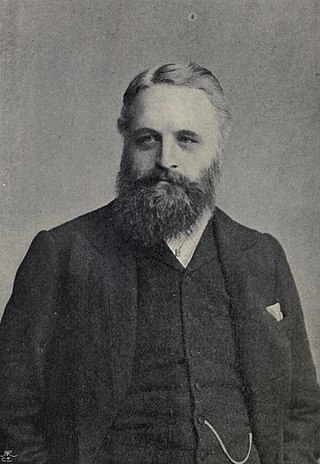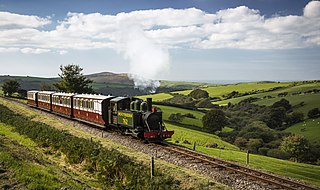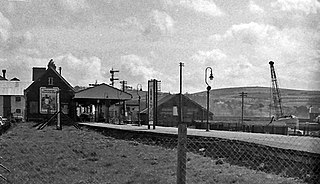
The London and North Western Railway was a British railway company between 1846 and 1922. In the late 19th century, the LNWR was the largest joint stock company in the world. In 1923, it became a constituent of the London, Midland and Scottish (LMS) railway, and, in 1948, the London Midland Region of British Railways. The LNWR's main line remains today as the English and Welsh portions of the West Coast Main Line.

Lynton is a town on the Exmoor coast in the North Devon district in the county of Devon, England, approximately 17 miles (27 km) north-east of Barnstaple and 18 miles (29 km) west of Minehead, and close to the confluence of the West Lyn and East Lyn rivers.

OO9, often also denoted as 009 or 00-9 is a model railway scale and gauge combination of 4 mm scale and 9 mm gauge tracks, which models a prototype track gauge of 2 ft 3 in. It is a common choice in the United Kingdom for the modelling of narrow-gauge railways whose prototype gauges lie approximately between 2 ft and 2 ft 6 in. The 9 mm track gauge is used by N gauge model railways, a common commercial scale, which means that a selection of wheels, track, and mechanisms is readily available.

Sir George Newnes, 1st Baronet was a British publisher and editor and a founding figure in popular journalism. Newnes also served as a Liberal Party Member of Parliament for two decades. His company, George Newnes Ltd, was known for such periodicals as Tit-Bits and The Strand Magazine; it continued publishing ground-breaking consumer magazines such as Nova long after his death.

The Lynton and Barnstaple Railway (L&B) opened as an independent railway in May 1898. It was a single track, 1 ft 11+1⁄2 in narrow gauge railway and was slightly over 19 miles (31 km) long running through the rugged and picturesque area bordering Exmoor in North Devon, England. Although opened after the Light Railways Act 1896 came into force, it was authorised and constructed prior to that act. Therefore, as with all other railways, it was authorised under its own Act of Parliament and built to higher standards than similar railways of the time. In the United Kingdom it was notable as being the only narrow gauge line required to use main-line standard signalling. For a short period the line earned a modest return for shareholders, but for most of its life the L&B made a loss. In 1923, the L&B was taken over by the Southern Railway, and eventually closed in September 1935.

Bratton Fleming railway station is a former station on the Lynton and Barnstaple Railway in England, a narrow gauge line that ran through Exmoor from Barnstaple to Lynton and Lynmouth in North Devon. The station served the village of Bratton Fleming. It opened with the line on 11 May 1898, and closed with it after service on 29 September 1935. From 1923 until closure, the line was operated by the Southern Railway.
Snapper Halt railway station was a station on the Lynton and Barnstaple Railway, a narrow gauge line that ran through Exmoor from Barnstaple to Lynton and Lynmouth in North Devon, England. The station served a rural area near the hamlet of Snapper.

There were more than a thousand British narrow-gauge railways ranging from large, historically significant common carriers to small, short-lived industrial railways. Many notable events in British railway history happened on narrow-gauge railways including the first use of steam locomotives, the first public railway and the first preserved railway.

Barnstaple Town railway station was an intermediate station on the L&SWR line to Ilfracombe, England.

Over the latter years of the 19th and early years of the 20th centuries, Penistone in Yorkshire gained a name as an accident black-spot on Britain's railway network; indeed, it could be said to hold the title of the worst accident black-spot in the country. The main line through the town was the Woodhead route of the Manchester, Sheffield and Lincolnshire Railway between Sheffield Victoria and Manchester, London Road. The line was heavily graded with a summit some 400 yards inside the eastern portal of the Woodhead tunnel.

The Lynton and Lynmouth Cliff Railway is a water-powered funicular joining the twin towns of Lynton and Lynmouth on the rugged coast of North Devon in southwest England.

Chelfham Viaduct is a railway viaduct built in 1896–97 to carry the single track, narrow-gauge Lynton and Barnstaple Railway (L&B) across the Stoke Rivers valley. Designed by L&B engineer, FW Chanter, and containing over a quarter of a million Marland bricks, its eight arches - each 42 feet (13 m) wide and 70 feet (21 m) high - meaning that the 132-yard (121 m)-long viaduct is the largest narrow gauge railway structure in England. Chelfham Viaduct was Bridge number 22 of the 80 that carried or spanned the railway over its 19-mile (31 km) length. The viaduct was classified as a Grade II listed structure on 25 February 1965.

Bratton Fleming is a large village, civil parish and former manor near Barnstaple, in Devon, England. It lies a few miles west of Exmoor. The parish is surrounded, clockwise from the north, by the parishes of Challacombe, Brayford, Stoke Rivers, Goodleigh, Shirwell, Loxhore, Arlington and Kentisbury. The population of the parish in 2001 was 942, falling to 928 in 2011. There is an electoral ward with the same name which at the 2011 census had a population of 2,117.
The Braunton Road railway accident occurred on 1 January 1910 in England. The Lynton & Barnstaple Railway maintained an exemplary safety record throughout its short existence from 1898 to 1935, with no passenger or member of the public having ever been injured or killed.
The Rolling stock of the Lynton and Barnstaple Railway was one of the most distinctive aspects of the 1 ft 11+1⁄2 in narrow gauge line which ran for almost twenty miles across Exmoor in North Devon, England, from 1898 to 1935.

Chelfham is a small borough in North Devon, England. It is situated between Bratton Fleming and Barnstaple. The village has a special needs school, and also a disused railway viaduct and station.

The Flemish Farm is a 1943 British war film, based on an actual wartime incident. Released during the war and used as a propaganda tool to support the Allied war effort, the film begins with the caption:

Shirwell is a village, civil parish and former manor in the local government district of North Devon, in the county of Devon, England. It was also formerly the name of a hundred of Devon. The village lies about 3.5 miles north-east of the town of Barnstaple, to the east of the A39 road to Lynton. The parish is surrounded clockwise from the north by the parishes of East Down, Arlington, Loxhore, Bratton Fleming, Goodleigh, Barnstaple, West Pilton and Marwood. In 2001 its population was 333, little changed from the 1901 figure of 338.

The Tarka Valley Railway in Devon, England, is a heritage railway that plans to rebuild the Torrington to Bideford section of the Barnstaple to Halwill Junction railway line. So far a short demonstration line of 300 yd of track in the direction of Bideford plus a siding alongside the old coal dock have been re-laid. The railway has been fenced off from the Tarka Trail ensuring the safety of all involved. Restoration of various items of rolling stock is currently under way.















